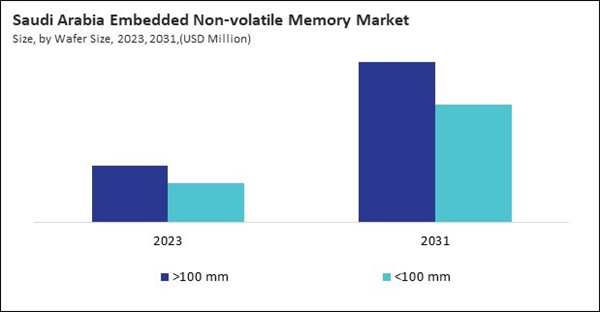The Brazil market dominated the LAMEA Embedded Non-volatile Memory Market by Country in 2023, and would continue to be a dominant market till 2031; thereby, achieving a market value of $145.1 million by 2031. The Argentina market is showcasing a CAGR of 13.9% during (2024 - 2031). Additionally, the UAE market would register a CAGR of 12.2% during (2024 - 2031).
Connected public services, from waste management to emergency response systems, are integral to smart cities. These services rely on real-time data collection and analysis to function effectively. For instance, smart waste management systems use sensors to monitor bin levels and optimize collection routes, while emergency services use connected systems to coordinate rapid responses to incidents. In these scenarios, eNVM is essential for storing sensor data, configuration settings, and operational parameters, ensuring these systems operate smoothly and efficiently.
Nevertheless, the market is not without its share of obstacles. The steep cost of eNVM technologies, particularly those that employ advanced processes such as FinFET and FD-SOI, is one of the primary obstacles. These manufacturing techniques require specialized equipment and materials, increasing production costs that can be prohibitive for smaller manufacturers or those in emerging markets. Additionally, the complexity of integrating eNVM into semiconductor chips can result in longer development cycles and a higher risk of production errors, further adding to the overall cost and time to market. As a result, some manufacturers may be hesitant to adopt eNVM, particularly when simpler and more established memory technologies are available at a lower cost.
The Brazilian government’s focus on digital transformation, including smart city initiatives and adopting Industry 4.0 practices, further propels the demand for eNVM. These initiatives emphasize automation, real-time data analysis, and connected systems, all of which require high-performance, non-volatile memory to ensure the efficiency and security of data handling processes. The country’s growing emphasis on smart manufacturing and industrial automation is a notable example of how eNVM technologies such as MRAM and FRAM provide fast, reliable memory solutions for industrial machinery and sensors in manufacturing environments. Thus, these elements are key drivers of the regional embedded non-volatile memory market's growth.
Based on Wafer Size, the market is segmented into >100 mm and < 100 mm. Based on Product, the market is segmented into eFlash, eE2PROM, FRAM, and Other Product. Based on Application, the market is segmented into BFSI, Information Technology, Consumer Electronics, Telecommunications, Government, and Others Application. Based on countries, the market is segmented into Brazil, Argentina, UAE, Saudi Arabia, South Africa, Nigeria, and Rest of LAMEA.
List of Key Companies Profiled
- Samsung Electronics Co., Ltd. (Samsung Group)
- Micron Technology, Inc.
- ROHM Co., Ltd.
- Toshiba International Corporation
- Honeywell International Inc.
- Fujitsu Limited
- Infineon Technologies AG
- Intel Corporation
- NXP Semiconductors N.V.
- STMicroelectronics N.V.
Market Report Segmentation
By Wafer Size
- >100 mm
- < 100 mm
By Product
- eFlash
- eE2PROM
- FRAM
- Other Product
By Application
- BFSI
- Information Technology
- Consumer Electronics
- Telecommunications
- Government
- Others Application
By Country
- Brazil
- Argentina
- UAE
- Saudi Arabia
- South Africa
- Nigeria
- Rest of LAMEA
Table of Contents
Companies Mentioned
- Samsung Electronics Co., Ltd. (Samsung Group)
- Micron Technology, Inc.
- ROHM Co., Ltd.
- Toshiba International Corporation
- Honeywell International Inc.
- Fujitsu Limited
- Infineon Technologies AG
- Intel Corporation
- NXP Semiconductors N.V.
- STMicroelectronics N.V.
Methodology

LOADING...









